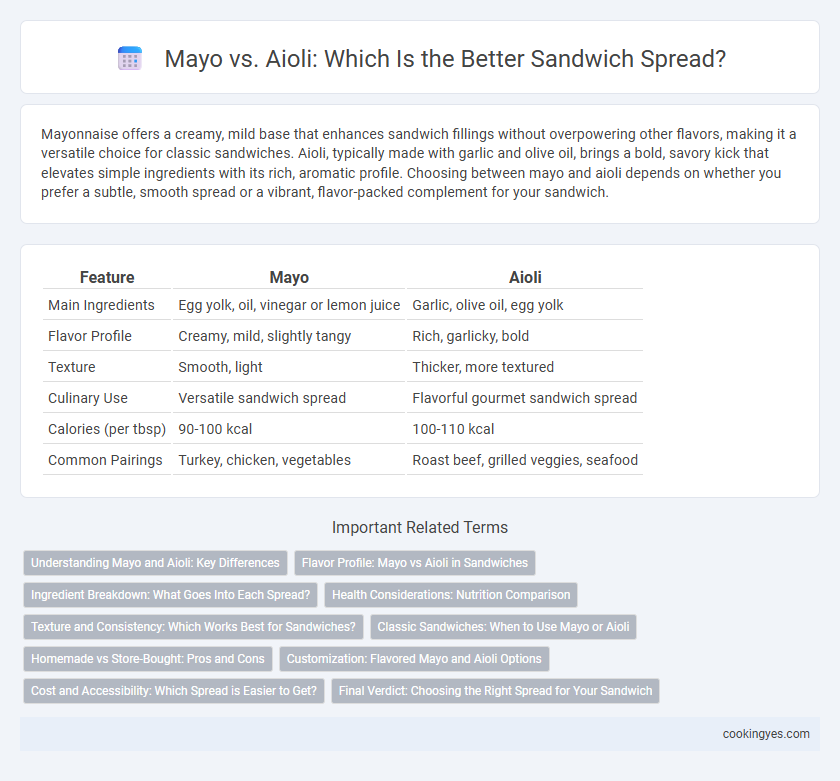Mayonnaise offers a creamy, mild base that enhances sandwich fillings without overpowering other flavors, making it a versatile choice for classic sandwiches. Aioli, typically made with garlic and olive oil, brings a bold, savory kick that elevates simple ingredients with its rich, aromatic profile. Choosing between mayo and aioli depends on whether you prefer a subtle, smooth spread or a vibrant, flavor-packed complement for your sandwich.
Table of Comparison
| Feature | Mayo | Aioli |
|---|---|---|
| Main Ingredients | Egg yolk, oil, vinegar or lemon juice | Garlic, olive oil, egg yolk |
| Flavor Profile | Creamy, mild, slightly tangy | Rich, garlicky, bold |
| Texture | Smooth, light | Thicker, more textured |
| Culinary Use | Versatile sandwich spread | Flavorful gourmet sandwich spread |
| Calories (per tbsp) | 90-100 kcal | 100-110 kcal |
| Common Pairings | Turkey, chicken, vegetables | Roast beef, grilled veggies, seafood |
Understanding Mayo and Aioli: Key Differences
Mayonnaise and aioli differ primarily in ingredients and flavor profiles; mayonnaise is an emulsion of oil, egg yolk, and vinegar or lemon juice, offering a creamy, neutral taste that enhances sandwich fillings without overpowering them. Aioli, traditionally made from garlic, olive oil, and sometimes egg, provides a rich, bold garlic flavor that adds depth and complexity to sandwiches. Understanding these differences helps in selecting the ideal spread for balancing taste and texture in various sandwich recipes.
Flavor Profile: Mayo vs Aioli in Sandwiches
Mayonnaise offers a creamy, mildly tangy flavor that complements a wide range of sandwich ingredients without overpowering them. Aioli, traditionally made with garlic and olive oil, provides a more robust, savory taste that enhances sandwiches with bold, Mediterranean-inspired fillings. Choosing between mayo and aioli depends on the desired flavor intensity and the specific sandwich combination.
Ingredient Breakdown: What Goes Into Each Spread?
Mayonnaise typically consists of a base of egg yolks, oil (often soybean or canola), vinegar or lemon juice, and salt, resulting in a creamy and mildly tangy spread. Aioli is traditionally made from garlic, olive oil, and egg yolks, delivering a richer, more robust flavor with a pronounced garlic presence. The key difference lies in aioli's emphasis on fresh garlic and olive oil, while mayonnaise relies on a neutral oil and vinegar for its signature taste, impacting the sandwich's overall flavor profile.
Health Considerations: Nutrition Comparison
Mayo and aioli differ in their nutritional profiles, with traditional mayo typically containing higher amounts of calories and fat due to its base of egg yolks and oil, while aioli, made primarily from olive oil and garlic, offers more heart-healthy monounsaturated fats and antioxidants. Mayo often includes additives and preservatives, whereas genuine aioli is usually free from these, making it a more natural option. Choosing aioli can enhance sandwich health benefits by providing anti-inflammatory properties and potentially lower saturated fat content compared to conventional mayonnaise.
Texture and Consistency: Which Works Best for Sandwiches?
Mayonnaise offers a smooth, creamy texture with a light consistency that evenly coats sandwich bread without overpowering other ingredients. Aioli provides a thicker, richer spread with a slightly grainy texture due to its traditional garlic emulsification, adding a robust mouthfeel to sandwiches. For a sandwich, mayonnaise excels in creating a balanced, moist bite, while aioli enhances flavor complexity with a heartier, more textured layer.
Classic Sandwiches: When to Use Mayo or Aioli
Classic sandwiches benefit from mayo's creamy, neutral flavor that enhances ingredients like turkey, ham, or chicken without overpowering them. Aioli, with its garlicky richness, pairs best with Mediterranean or roasted vegetable sandwiches to add depth and a bold taste profile. Choosing mayo or aioli depends on the sandwich's overall flavor balance and whether a subtle or robust spread is desired.
Homemade vs Store-Bought: Pros and Cons
Homemade mayo offers control over ingredients and freshness, making it ideal for personalized sandwich spreads, though it demands time and precision. Store-bought mayo provides convenience and consistent texture, but often contains preservatives and stabilizers that may affect flavor. Homemade aioli, typically combining garlic and olive oil, delivers a robust, artisanal taste perfect for gourmet sandwiches, whereas store-bought aioli balances ease of use with less intense flavor profiles.
Customization: Flavored Mayo and Aioli Options
Mayo offers a versatile base for customization with popular flavored options like garlic, chipotle, and herb-infused varieties that enhance sandwich spreads. Aioli, traditionally made from garlic and olive oil, allows for creative twists incorporating ingredients such as roasted red peppers, basil, or truffle to elevate taste and texture. Both flavored mayo and aioli provide rich, creamy layers that can be tailored to complement various sandwich ingredients, creating unique and personalized culinary experiences.
Cost and Accessibility: Which Spread is Easier to Get?
Mayonnaise is widely available in most grocery stores and is generally more affordable, making it a cost-effective option for sandwich spreads. Aioli, often made with garlic and olive oil, tends to be pricier and less commonly stocked, especially outside specialty or gourmet shops. For everyday accessibility and budget-friendly choices, mayo is typically easier to obtain and use.
Final Verdict: Choosing the Right Spread for Your Sandwich
Mayonnaise offers a classic creamy texture with a mild flavor that complements most sandwich ingredients, making it a versatile choice. Aioli, often infused with garlic and herbs, provides a bold and savory punch that enhances sandwiches with robust fillings like grilled vegetables or meats. Selecting the right spread depends on your sandwich's flavor profile and desired taste intensity, with mayo favoring subtlety and aioli delivering a more intense, gourmet experience.
Mayo vs aioli for sandwich spreads Infographic

 cookingyes.com
cookingyes.com